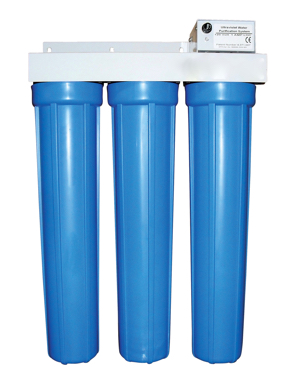UV Systems for Drinking Water
Ultraviolet (UV) radiation has been used as a water cleaning agent for more than a hundred years, and it has proved to be effective. Health care institutions have been using UV technologies for decades to sanitize rooms and equipment.
Until recently, UV light water filtration systems were used by large water supply services only. Now there are fairly compact UV water purification devices intended for home use. There are various types of water contamination, and UV is used to deal with biological (bacterial, fungal, etc.) contamination. It has proved to effectively destroy various pathogenic microorganisms, which cause severe gastrointestinal disorders (escherichia coli, salmonella, shigella dysentariae, etc.), poliomyelitis (poliovirus), diphtheria (corynebacterium diphtheria), etc.
How it works
UV light penetrates water and leaves zero chance for bacteria, viruses, fungi, protozoa, and other human pathogens. The light attacks microorganisms and, most important, obliterates their DNA. It does not actually kill these organisms. It targets their reproductive function and robs them of their ability to reproduce. Short-wave UV light (2000-2950 A) has a greater germicidal potential than medium- and long-wave UV light. This type of UV light does not penetrate into the atmosphere, and what we get from the sun is just the medium- and long-wave UV light. It means that we have to use artificially generated UV light.
The light is emitted by a low-pressure quartz glass mercury vapor lamp. The glass lets through short-wave UV radiation, which is generated through vaporization and ionization of mercury with the help of an electric arc.
It is important that water being purified have passed through a 5-micron filter. There should be no sediment or debris, which will otherwise block the UV light and shield microorganism against the light.
Why use a UV system?
There are good reasons to use UV, because the technology is:
- Eco-friendly: there is no need to use chlorine or other chemicals, which can produce toxic byproducts and spoil water.
- Energy-efficient: it takes as much energy as a regular electric bulb.
- Low maintenance: the only thing you need to do about your device is replace bulbs at least once a year. Also, you will need to clean the quartz sleeve to ensure effective UV emission and disinfection.
- Harmless: it will not affect your plumbing system.
- Beneficial for water: it does not destroy healthy minerals and does not cause odors or affect water’s taste.
Use other methods as well
Bacterial decontamination is only part of the complex process that is water purification. Therefore, it should not be confined to UV treatment, because it does not eliminate chemicals, debris or sediment from water. It is advisable to combine the technique with other water purification methods, such as carbon block and reverse osmosis.
How do I choose a device?
If you are going to UV-treat water in your home, choose a UV unit of appropriate size and capacity. Calculate your household peak demand flow rate - an indicator reflecting a maximum amount of water your system can let through with all taps turned on. This may require professional help.


